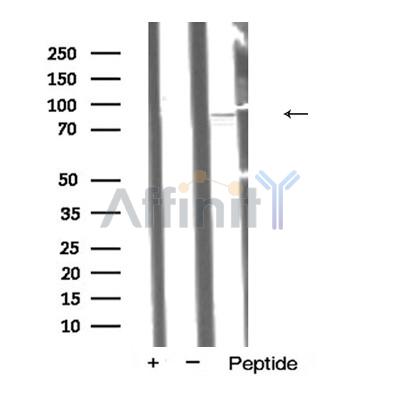ATRIP Antibody - #AF5417
| Product: | ATRIP Antibody |
| Catalog: | AF5417 |
| Description: | Rabbit polyclonal antibody to ATRIP |
| Application: | WB IHC |
| Reactivity: | Human, Mouse, Rat |
| Prediction: | Bovine, Sheep, Rabbit |
| Mol.Wt.: | 85 kDa; 86kD(Calculated). |
| Uniprot: | Q8WXE1 |
| RRID: | AB_2837901 |
Related Downloads
Protocols
Product Info
*The optimal dilutions should be determined by the end user. For optimal experimental results, antibody reuse is not recommended.
*Tips:
WB: For western blot detection of denatured protein samples. IHC: For immunohistochemical detection of paraffin sections (IHC-p) or frozen sections (IHC-f) of tissue samples. IF/ICC: For immunofluorescence detection of cell samples. ELISA(peptide): For ELISA detection of antigenic peptide.
Cite Format: Affinity Biosciences Cat# AF5417, RRID:AB_2837901.
Fold/Unfold
AGS1; ATIP; ATM and Rad3 related interacting protein; ATM and Rad3-related-interacting protein; ATR interacting protein; ATR-interacting protein; Atrip; ATRIP_HUMAN; DKFZp762J2115; FLJ12343; MGC20625; MGC21482; MGC26740;
Immunogens
A synthesized peptide derived from human ATRIP, corresponding to a region within the internal amino acids.
- Q8WXE1 ATRIP_HUMAN:
- Protein BLAST With
- NCBI/
- ExPASy/
- Uniprot
MAGTSAPGSKRRSEPPAPRPGPPPGTGHPPSKRARGFSAAAAPDPDDPFGAHGDFTADDLEELDTLASQALSQCPAAARDVSSDHKVHRLLDGMSKNPSGKNRETVPIKDNFELEVLQAQYKELKEKMKVMEEEVLIKNGEIKILRDSLHQTESVLEEQRRSHFLLEQEKTQALSDKEKEFSKKLQSLQSELQFKDAEMNELRTKLQTSERANKLAAPSVSHVSPRKNPSVVIKPEACSPQFGKTSFPTKESFSANMSLPHPCQTESGYKPLVGREDSKPHSLRGDSIKQEEAQKSFVDSWRQRSNTQGSILINLLLKQPLIPGSSLSLCHLLSSSSESPAGTPLQPPGFGSTLAGMSGLRTTGSYDGSFSLSALREAQNLAFTGLNLVARNECSRDGDPAEGGRRAFPLCQLPGAVHFLPLVQFFIGLHCQALQDLAAAKRSGAPGDSPTHSSCVSSGVETNPEDSVCILEGFSVTALSILQHLVCHSGAVVSLLLSGVGADSAAGEGNRSLVHRLSDGDMTSALRGVADDQGQHPLLKMLLHLLAFSSAATGHLQASVLTQCLKVLVKLAENTSCDFLPRFQCVFQVLPKCLSPETPLPSVLLAVELLSLLADHDQLAPQLCSHSEGCLLLLLYMYITSRPDRVALETQWLQLEQEVVWLLAKLGVQSPLPPVTGSNCQCNVEVVRALTVMLHRQWLTVRRAGGPPRTDQQRRTVRCLRDTVLLLHGLSQKDKLFMMHCVEVLHQFDQVMPGVSMLIRGLPDVTDCEEAALDDLCAAETDVEDPEVECG
Predictions
Score>80(red) has high confidence and is suggested to be used for WB detection. *The prediction model is mainly based on the alignment of immunogen sequences, the results are for reference only, not as the basis of quality assurance.
High(score>80) Medium(80>score>50) Low(score<50) No confidence
Research Backgrounds
Required for checkpoint signaling after DNA damage. Required for ATR expression, possibly by stabilizing the protein.
Phosphorylated by ATR.
Nucleus.
Note: Redistributes to discrete nuclear foci upon DNA damage.
Ubiquitous.
The EEXXXDDL motif is required for the interaction with catalytic subunit PRKDC and its recruitment to sites of DNA damage.
Belongs to the ATRIP family.
Research Fields
· Genetic Information Processing > Replication and repair > Fanconi anemia pathway.
Restrictive clause
Affinity Biosciences tests all products strictly. Citations are provided as a resource for additional applications that have not been validated by Affinity Biosciences. Please choose the appropriate format for each application and consult Materials and Methods sections for additional details about the use of any product in these publications.
For Research Use Only.
Not for use in diagnostic or therapeutic procedures. Not for resale. Not for distribution without written consent. Affinity Biosciences will not be held responsible for patent infringement or other violations that may occur with the use of our products. Affinity Biosciences, Affinity Biosciences Logo and all other trademarks are the property of Affinity Biosciences LTD.
